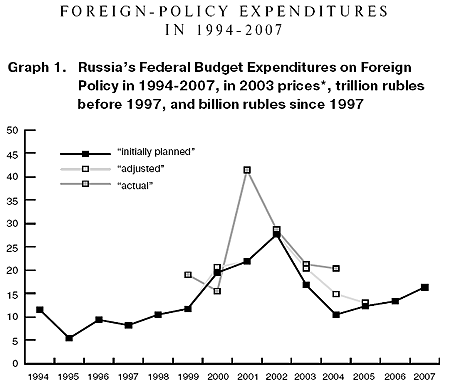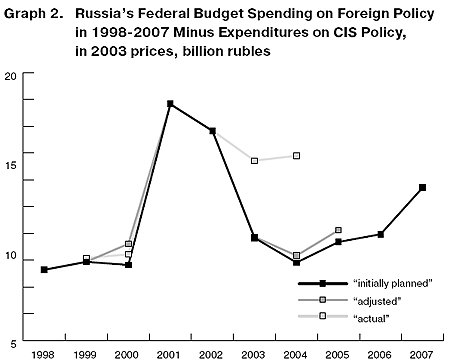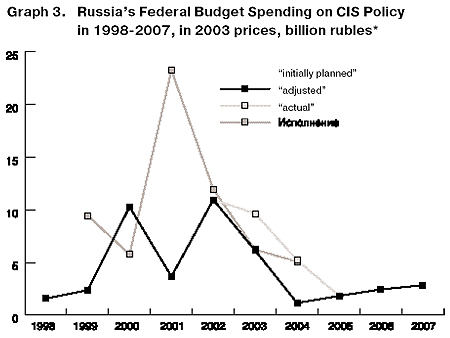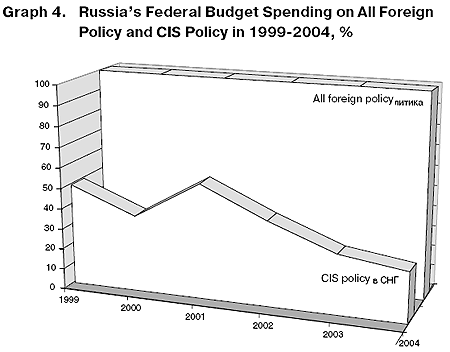seemingly simple question is actually very difficult to answer.
First, foreign policy comprises a huge number of many diverse
processes and factors, and these are not easy to evaluate in terms
of money. Second, many parts of Russia’s federal budget that
concern foreign policy are either too general or they are
classified. Finally, the amount of available information on
different foreign-policy sectors differs considerably.
Nevertheless, this article is an
attempt to analyze Russia’s budget spending on foreign policy. A
generalization of these spending figures has produced interesting
and, at the same time, contradictory results, making it difficult
to draw any unequivocal conclusions on their basis. Yet an analysis
of the situation, presented with diagrams and graphs, is very
useful and provides much food for thought.
SOME METHODOLOGICAL
EXPLANATIONS
Russia’s budget spending is
classified into three categories. These include functional (budget
allocations for national defense, police, state security,
education, etc.), departmental (allocations among government
agencies) and economic.
First, there is no item listed
under “foreign policy” in the functional distribution of spending.
Rather, it is financed from a sub-item category called
“International Relations and International Cooperation” (before
2005 it was called “International Cooperation”), which is included
in the “General State Spending” item. However, business trips
abroad and international contacts of all state organizations, such
as the Audit Chamber, the Federal Tariffs Service, the Ministry for
Regional Development, etc., are financed from the same source. So,
as regards functional classification, allocations for foreign
policy and diplomacy merge with other spending.
It would be logical to assume that
the “cost” of foreign policy will be apparent from the departmental
classification. Theoretically, the budget of the Foreign Ministry
(in former years also the Ministry for CIS Affairs, the Ministry
for Cooperation with the CIS Countries, and the Russian Center for
International Cooperation in Science and Culture under the Foreign
Ministry) must reflect all foreign-policy allocations. But things
are not that simple. For example, allocations for the Foreign
Ministry in 2000 in the open (unclassified) variant of the federal
budget stood at 589 million rubles; in 2001 they made 706 million
rubles, and in 2002, 1,065 million (all the sums are given in
current prices).
Apparently, everything seems
clear: the budget of the Foreign Ministry is small but growing
(even if adjusted for inflation). However, if we look at the budget
execution report for 2001, we will find the figure of 13.5 billion
rubles (instead of 706 million). The point is not that the spending
proved to be much greater than planned, although such things happen
and we will discuss that scenario below. The point is that not all
foreign-policy allocations were made through the Foreign Ministry.
For example, the international organizations’ dues and other
expenditures involved in foreign-policy activity were for many
years paid through the Ministry of Finance. (In 2001, part of the
expenditures was paid from the budget of the Ministry of Finance,
although the budget execution report attributed this spending to
the Foreign Ministry’s budget.) For this and other reasons, in
1995-2001 the Foreign Ministry received meager allocations in the
open variant of the federal budget. It would seem that one could
simply look at corresponding categories and sub-categories in the
departmental classification of the Finance Ministry’s spending and
add the expenditures specified there to the foreign-policy budget.
However, in some years the Finance Ministry was not mentioned in
open variants of the departmental classification of
spending.
Given these factors, the author
has worked out his own method for estimating Russia’s expenditures
on foreign policy. In brief, these expenditures include:
– allocations under the
sub-category of “International Relations and International
Cooperation,” received by the Foreign Ministry (minus allocations
for “Implementation of Interstate Agreements Within the CIS
Frameworks,” also received by the ministry);
– all allocations for
“Implementation of Interstate Agreements Within the CIS
Frameworks.” Although this budget item is included in the
sub-category entitled, “International Relations and International
Cooperation,” I have singled it out because allocations for this
purpose are not made through the Foreign Ministry alone;
– allocations received by the
Foreign Ministry under other categories and sub-categories of the
functional classification (for education, construction,
etc.).
In 1995-2001, the sub-category
“International Cooperation” obviously was not fully presented in
the Foreign Ministry’s budget – a significant amount of funds is
paid through the Ministry of Finance. But even there they are not
always fully reflected because of the budget structure, as well as
for reasons of secrecy. Allocations for foreign policy under the
“International Cooperation” sub-category must have stood then at 90
percent of the Foreign Ministry’s budget (this is only an
estimation, because such a ratio has been in effect since just 2002
when the budget became less classified).
Importantly, the federal budget
expenditures under review do not include additional incomes that
Russian institutions abroad receive from allowed kinds of activity
(these incomes are for the first time fully included in the 2007
budget; however, this data is inaccessible to the public and is
contained in a classified supplement). Throughout the years under
review, there have existed such incomes that increased
foreign-policy budgets by an unknown value (hardly a significant
one, though).

* Current prices for 2003 were
converted into fixed ones by means of a GDP deflator, which was
calculated by the Federal State Statistics Service (the deflator
index for 2006 and 2007 is estimated at 1.09 and 1.08,
respectively). Inflation rates differ in different sectors of the
economy. Therefore, the GDP deflator used for a particular category
of expenditures cannot produce an absolutely precise adjustment for
inflation – for foreign-policy expenditures the inflation was
probably higher or lower than the GDP deflator. Yet, however
notional the deflator index may be, there is no alternative to it.
The inflation rate calculated for each specific year may not be
absolutely precise, but in any case, the figures produced are
commensurable and, at least, must adequately reflect the present
tendencies.
Graph 1 shows the following three
curves:
1) “initially planned” –
allocations approved when adopting the federal budget;
2) “adjusted” – allocations
adjusted as the federal budget was being fulfilled (as of the end
of the fiscal year);
3) “actual” – actual expenses
specified in reports on the federal budget execution (such reports
have been adopted only since 1999, and two years after the
termination of a corresponding fiscal year; so at the time this
article was written only data for 1999-2004 was
available).
The three curves do not always
coincide. This is a widespread practice: budgets are often adjusted
in the course of a fiscal year. Moreover, sometimes they may exceed
even the adjusted targets. The years 2000, 2003 and 2004 are
particularly indicative in this respect: in those years, the
originally planned, adjusted and actual budgets had absolutely
different values.
The period between 1998 and 2002
saw a continuous growth in foreign-policy allocations.
Interestingly, the 2000 budget provided for an essential increase
in these allocations as compared with the previous year. However,
the actual expenditures in 2000 were less than planned. The same
tendency was observed in other spheres as well: the Defense
Ministry and security services, for example, whose budgets for the
2000 fiscal year had been considerably increased (due to additional
budget incomes), did not utilize all the funds allocated to
them.
Allocations reached their peak in
2002, while actual expenditures (according to budget execution
reports) peaked in 2001. In 2003-2004, both parameters considerably
decreased. In 2004, general allocations for foreign policy returned
to the 1998 level. Since 2005, foreign-policy allocations have been
moderately growing.
EXPENDITURES ON FOREIGN
POLICY MINUS THE
CIS
Graph 2 shows that the volatility
of foreign-policy expenditures is much less if the CIS is not taken
into account. The difference between a planned budget and actual
expenditures was insignificant before 2003.
The budget execution curve
reflects a minor decrease after the 2001 peak; foreign-policy
expenditures remain much higher than in the late 1990s. One can
even say that these expenditures (provided that spending on foreign
policy in the CIS is not taken into account) have stabilized at a
level that is rather high for Russia.
Therefore, expenditures on CIS
policy since 2000 have essentially influenced the dynamics of all
foreign policy spending, and in some way actually “distorted”
it.

EXPENDITURES ON CIS
POLICY
The aforementioned volatility of
foreign policy spending is perfectly illustrated in Graph 3.
Throughout the last decade, there has been a discrepancy between
budget allocations on foreign policy and actual spending: in some
years, the spending was more than planned, while in others it was
less. Indicative in this respect is the year 2001, when foreign
policy spending was planned in lesser amounts than the allocations
and actual spending in 2000. However, actual foreign policy
spending in 2001 by far exceeded the figure for the previous year.
The year 2001 was a peak year for investment in foreign policy in
the CIS.
In subsequent years foreign policy
allocations essentially decreased. And although in 2005-2007 the
budget has been somewhat growing, still it remains at the level of
the late 1990s. In 2004, however, actual spending was more than 300
percent higher than initially planned. Most likely, the same is for
the period of 2005-2006 (figures for these years are still
unavailable). Nevertheless, spending for 2004-2007 will be much
less than it was for 2001 and 2002.

* Spending on CIS policy comprises
allocations for the program entitled, Implementation of Interstate
Treaties Within the CIS Frameworks. This budget item includes
allocations not only for policy toward the CIS proper, but rather
for policy in the CIS space, as well as spending on the Collective
Security Treaty Organization, the Eurasian Economic Community
(EurAsEC) and other organizations. Allocations for CIS policy were
for the first time made a special federal budget item in 1998. No
precise figures concerning CIS policy in the previous years can be
obtained from open sources.
TOTAL/CIS SPENDING
RATIO
These figures are given in Graph 4
(it contains only actual spending figures, so it refers only to the
period of 1999-2004, for which there are budget execution reports).
This factor simplifies the diagram; besides, actual spending
figures are more important than planned allocations. We have
already seen discrepancy between planned and actual allocations
with regard to all foreign policy spending (Graph 1) and spending
on CIS policy (Graph 3).
Graph 4 shows that since 2001,
funds spent on CIS policy have been steadily decreasing. In the
late 1990s, approximately half of all allocations that were set
aside for foreign policy was spent on neighboring countries. In
2001, this ratio was repeated due to a sharp increase in actual
financing. In subsequent years, however, spending on CIS policy
steadily decreased, amounting to just 25 percent in
2004.

budget, the share of funds for CIS policy within the entire
category of foreign policy spending decreased even further to 17-20
percent. In 2005 and 2006, however, spending on CIS policy grew
faster than all foreign policy spending (although the 2007 budget
is marked by a reverse trend). If actual spending in 2005-2007 does
not radically differ from the budget plans, the share of CIS policy
spending will stabilize at about 20
percent.
SOME
CONCLUSIONS
The
abovementioned figures suggest the following
conclusions:
-
the period
2000-2003 saw unusually high spending rates on all foreign policy
projects (it grew particularly high in 2001 but then decreased,
although remaining at a high level in the next two
years); -
the
foreign-policy budget (not including spending on CIS policy)
decreased after 2001; yet it stabilized at levels considerably
higher than in the late 1990s; -
allocations
for CIS policy after 2000 fluctuated violently and eventually fell
to the level of the late 1990s. Correspondingly, after 2001 their
share in total foreign policy spending steadily decreased to half
the figure of the late 1990s.
If we convert
these quantitative (budget) parameters into qualitative (political)
ones, we can assume that after Russian President Vladimir Putin
came to power, he took an active foreign-policy position, backing
it with an increased foreign-policy budget. After a sharp growth
and subsequent decline, this budget (not including CIS policy) has
stabilized at a level that is high for Russia.
The
uncertainty and inconsistency of foreign policy in the post-Soviet
space brought about considerable fluctuations in spending. In
correspondence with statements about the high priority that CIS
policy plays for Russia, financing in this field increased
considerably in individual years. Of special interest is the year
2001 when actual spending increased to particularly high
rates.
Today,
statements concerning the high priority of foreign policy in the
CIS are still made, but they are not consistent with the continuing
decrease in spending on this policy within foreign-policy
allocations.
Let’s once
again return to a factor on which we focused our attention above:
it often happens that initially planned, adjusted and actual budget
allocations differ essentially. In my view, this is a telltale sign
(even though indirect) of the insignificant role that parliament
plays in the implementation of foreign policy. The executive branch
makes decisions and implements them at its own discretion, without
letting parliament in on its plans – even when the federal budget
is to be endorsed. Actually, the executive branch spends as much
funds as it sees fit.
At the same
time, the volatility of foreign policy spending reveals the main
problem: political decisions in Russia are poorly translated into
budgetary categories and specific plans with a particular price
tag. As a result, the executive branch often fails to stay within
specific budgetary limits.
The inability
to estimate and plan the financial parameters of a particular
policy is an adverse factor that may have negative consequences.
There is a danger to assume superfluous political and, therefore,
financial obligations, or, on the contrary, to be too cautious and
leave part of the resources unused unwittingly and without any
grounds. In the first case, risks increase; in the second,
efficiency decreases. A country seeking to return to the global
stage as a major actor must find a well-planned solution to the
problem of providing its foreign policy with sufficient
resources.










